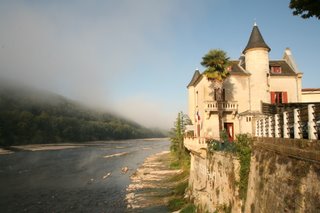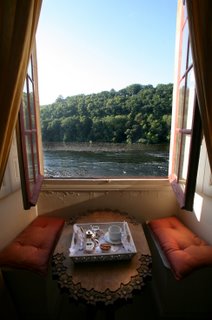What a clever idea -- and what a service to all potential American (and other)visitors to Europe!
In the Travel Diary , Suzanne Pidduck, a veteran traveller, provides a list of do's and don’ts for Americans who are planning a visit to Europe. In this piece there are several points that seasoned travellers would not even think about, and, anyone who loves travel and discovering the world, anyone who adores experiencing new ideas, new cultures, customs, foods, smells, sights, anyone who is hooked on surprises and 'firsts', would probably cock a snoot at this article. And yet -- and yet............ there are thousands upon thousands of people daily who are planning their very first visit outside their own comfort zone, and as we know, that is an experience that can very easily bring out the worst in any person. The fear of the unknown -- be it foreign people, foreign places, foreign food, foreign cultures, religions and customs, all too often make people turn nasty and defensive, ugly and dangerous.
When I see people talking about the American quality of life or the American standards of living being very high -- and that in comparison with Europe, it usually gets my hackles rising -- especially when, in the next sentence they write
'We’re used to king size beds and bathrooms that can accommodate several people at a time'. One does not wonder that there are such huge gaps in communication and understanding between different sectors of the world population. The Europeans generally discovered centuries ago, before the new world was even colonized, that quality of life and standards of living have very little, if anything to do with the size of ones bed -- or of ones anything, for that matter! Quality of life and standards of living are about comfort, yes, but comfort of a good value system, confidence, ethics, education, culture, health, friendship and family.
Nevertheless,
'Chapeau!' to Suzanne for providing these guidelines --- writing about everyday little things, such as bathrooms that are 'creative', beds that are smaller, furniture that is 'old',(lol! this is not the first time I have come across people who think that priceless antique heirlooms are nothing more than second-hand used furniture!), not everyone in the world being able to speak English, is actually a very good and helpful idea. And her final recommendation -- to set off on your travels with the right attitude, sums up the article perfectly - if only EVERONE would pack that little titbit into their travel luggage, the world would most certainly be a happier place!
--- Every person who is travelling outside their own little habitat, should read this article! This is what she writes:American Standards and European Culture: How to Avoid a Disappointing Vacation Experience While TravellingPosted in
Travel on the April 10th, 2007
Planning a vacation to Europe? No doubt you have certain expectations about your upcoming journey.
Perhaps you’re the kind of person who expects to spend your days admiring amazing architecture and prowling world-famous museums for masterpieces. Or maybe you’re going to Europe to meet interesting people, relax on the beach until the sun goes down, and dance the night away in a local club. Regardless of your European vacation priorities, you certainly expect it to be wonderful!
But stop a moment. Have you thought about your cultural expectations?
 Duane Hanson, the American photorealist. One of his sculptures in the Saatchi collection
Duane Hanson, the American photorealist. One of his sculptures in the Saatchi collectionMany European vacationers plan their activities and accommodations with the assumption that everything else will be “like America.” If so, think again! Just as Europe and the US are different in landscape, weather, and history, they are also very different culturally. Europeans and Americans have different ideas about manners, time, personal space, personal property maintenance, and language.
So for anyone planning a vacation to Europe, here are a few “cross cultural conflict” areas that Americans traveling in Europe often encounter. Making yourself aware of these differences can help you have a fun, enjoyable, and even educational European vacation that is free of cultural misunderstandings!
Personal SpaceTake a glance at a map of the world. Which is smaller: the US or Europe? That’s right– Europe. But there are still a lot of people there, which means they’ve gotten used to smaller spaces!
American standards of living are very high. We’re used to king size beds and bathrooms that can accommodate several people at a time.
But unless you’re staying in a massive French chateau or Italian villa, be prepared for spaces to be smaller than you’re used to. Bedrooms will be more compact, as will bed sizes. Single and double beds alike will be narrower. Most bathrooms have been added into older houses in modern times, so they are often “creative” in both location and structure. Kitchens won’t be able to accommodate your entire family!
So consider this an opportunity to get closer to your traveling companions. Think of sharing a bathroom in Italy as an exercise in cooperation. Get cozy with your spouse in that French double bed. Be willing to laugh as you adjust. Get creative and have fun!
MannersA common misperception of Europeans is that they are “rude.” Of course, they think the same thing about us!
Remember when you’re traveling in Europe that rudeness is largely a cultural perception. Someone who seems blunt and nosey may be expressing friendship and concern for your well-being. A waiter who tells you what to order may be trying to help, since you are unfamiliar with the language. Differences in “personal space” mean that someone who pushes in front of you may wonder why you’re not fighting for your space in line!
Also, subjects which are taboo in your community may be freely discussed elsewhere, and vice versa. In the US, we consider it incredibly rude to comment on a person’s weight. This isn’t true everywhere in the world!
So, when traveling in Europe, keep a firm grip on your temper. A good way to achieve this is to give everyone else the benefit of the doubt. Just make the choice not to get angry. If you can roll with the punches, you’ll enjoy your vacation more– and you’ll be a better traveling companion.
TimeI have to admit that I get impatient if I have to wait longer than fifteen minutes at a restaurant in the US. After the food comes, I can be out the door in half an hour!
In Italy, however, a dinner filled with conversation, laughter, and great food can last two hours! I smile when I hear other Americans asking why the food hasn’t arrived yet. Unbeknownst to them, the waiters are offering them the opportunity to savor the meal.
Likewise, shops and businesses in Spain close for an afternoon siesta. In the UK, the handyman may want to chat with you before repairing that pipe.
Most Europeans do not share the American compulsion to “save time” by doing everything quickly. So when you vacation in Europe, leave your watch behind. After all, this is a vacation!
QualityI often hear complaints, especially from those who rent a villa or apartment, about the quality of the furnishings and amenities in Europe. I’d be a millionaire if I had a dime for every time I heard someone say “The furniture was old!” or “The bathroom pipes need to be replaced.”
In today’s society, we expect things to look like new, feel like new, and behave like new. If it doesn’t, we throw it away.
But think of anyone who grew up during the depression. My grandfather kept rows of old coffee cans filled with spare nails and bits of wire. He sat in the same chair every night until he died. Nothing was wasted, and nothing was thrown away if it could be fixed.
So if the furniture looks a little worn, or if the sink clogs, think before you complain. Is the quality due to neglect and disrepair, or is it the result of a careful, conscientious effort not to put anything to waste?
Treat this as an educational experience; you might even learn from a more conservative lifestyle.
LanguageAs an American, I am often jealous of Europeans who pick up languages like you’d pick up a bottle of milk at the store. For me, it’s an uphill battle all the way!
Since learning three or four languages is neither a cultural necessity nor a scholastic requirement in our country, many Americans feel like me. And yet some Americans still assume that everyone in Europe should speak English!
In the same way that you or I would resent a French tourist who expected everyone in the US to speak French, Europeans are often annoyed by Americans who have this mentality.
While you probably can’t learn a new language before your vacation, you can learn some helpful phrases. This is considered courteous, and is guaranteed to get more friendly responses. When you try to use their language, Italians or French who might have feigned ignorance will usually help you with your pronunciation– and then converse with you in English!
The Right AttitudeLastly, remember that the standards and the customs you find while traveling in Europe are not wrong. They’re just different. If you travel with the right attitude, you will have a richer, more authentic, and even eye-opening experience. Who knows? Your European vacation may change the way you see the world.
Click on Link:
Chateau Lalinde : The perfect venue for your event
Relocation Orientation Course : Come learn what to expect when you are travelling to France!
TAGS: Travel to France Rent a chateau France
Chateau
Americans in France Food Holidays in France Guidelines for Tourists
 the same! --- but I won't! However, it has to be mentioned that it is becoming more and more difficult to obtain Epsom Salts -- pharmacists are no longer keeping it and supermarkets often have never heard of it, so if you find some, let us all know where and stock up for yourself -- not only for this excellent lemon syrup recipe, but also for: 3 table spoons of Epsom Salts/Magnesium Sulphate around the base of your rose bushes and then well watered 3 or 4 times a year will boost their growth and yield of flowers like nothing you have ever seen -- trust me -- there is no fancy (expensive) fix at any garden centre that will beat that for prize winning roses!
the same! --- but I won't! However, it has to be mentioned that it is becoming more and more difficult to obtain Epsom Salts -- pharmacists are no longer keeping it and supermarkets often have never heard of it, so if you find some, let us all know where and stock up for yourself -- not only for this excellent lemon syrup recipe, but also for: 3 table spoons of Epsom Salts/Magnesium Sulphate around the base of your rose bushes and then well watered 3 or 4 times a year will boost their growth and yield of flowers like nothing you have ever seen -- trust me -- there is no fancy (expensive) fix at any garden centre that will beat that for prize winning roses!







.JPG)









